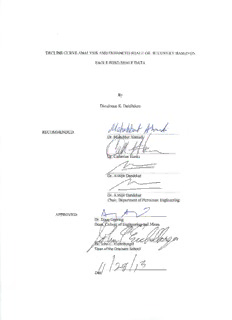
Hydrocarbon accumulations in petroleum reservoirs PDF
Preview Hydrocarbon accumulations in petroleum reservoirs
DECLINE CURVE ANALYSIS AND ENHANCED SHALE OIL RECOVERY BASED ON EAGLE FORD SHALE DATA By Dieudonne K. Delaihdem RECOMMENDED: _..,Dr. Abhijit Dandekar ~- Dr. Abhijit Dandekar Chair, Department of Petroleum Engineering APPROVED: DECLINE CURVE ANALYSIS AND ENHANCED SHALE OIL RECOVERY BASED ON EAGLE FORD SHALE DATA A THESIS Presented to the Faculty of the University of Alaska Fairbanks in Partial Fulfillment of the Requirements for the Degree of MASTER OF SCIENCE By Dieudonne K. Delaihdem, B.S. Fairbanks, Alaska December 2013 ABSTRACT Transient and fracture dominated flow regimes in tight permeability shale reservoirs with hydraulically fractured horizontal wells impose many unconventional challenges. These include execution of appropriate shale decline curve analysis and the optimization of hydrocarbons recovery. Additionally, short production profiles available are inadequate for accurate production decline analysis. This research assessed the effectiveness of Arps’ decline curve analysis and recently established methods- -power law exponential analysis, logistic growth analysis, Duong’s method and the author’s approach--to predict future production of horizontal wells in the Eagle Ford Shale. Simulation models investigated history matching, enhanced shale oil recovery, and drainage area beyond stimulated reservoir volume. Traditional Arps’ hyperbolic method sufficiently analyzed past production rates, but inaccurately forecasted cumulative productions. The recent decline models show slight variations in their past performance evaluations and forecasting future production trends. The technique proposed and used in this work enhanced the successful application of Arps’ hyperbolic decline from 32.5% to 80%. Simulation results indicate 4.0% primary oil recovery factor and 5.8% enhanced shale oil recovery factor using CO miscible injection. Based on pressure observed outside of the stimulated reservoir volume, 2 limited to the range of data used in this study, drainage area outside stimulated reservoir volume is not significant. vii DEDICATION To God is the Glory Praises to the Lord; His Love Endures Forever ix TABLE OF CONTENTS Signature Page……………………………………………………………………………………..i Title Page …………………………………………………………………………………………iii ABSTRACT ..................................................................................................................................... v DEDICATION ............................................................................................................................... vii TABLE OF CONTENTS ................................................................................................................ ix LIST OF FIGURES ...................................................................................................................... xiii LIST OF TABLES ....................................................................................................................... xxii ACKNOWLEDGEMENT .......................................................................................................... xxiv Chapter 1 Introduction ..................................................................................................................... 1 1.1 Shale Oil Reservoirs ............................................................................................................ 1 1.2 Shale Oil- What is it? ........................................................................................................... 2 1.3 Shale Play Development ...................................................................................................... 3 1.4 Purpose and Scope of Study ................................................................................................ 4 Chapter 2 Literature Review ............................................................................................................ 6 2.0 Introduction .......................................................................................................................... 6 2.1 Geology ................................................................................................................................ 7 2.2 Decline Curve Analysis ..................................................................................................... 11 2.2.1 Arps Decline Curve Analysis ..................................................................................... 12 2.2.2 Power Law Exponential Analysis .............................................................................. 15 2.2.3 Logistic Growth Analysis .......................................................................................... 16 2.2.4 Duong’s Method ........................................................................................................ 17 2.3 Analyses of the Eagle Ford Shale ...................................................................................... 19 2.3.1 Reservoir Fluids ......................................................................................................... 19 x 2.3.2 Natural Fractures ........................................................................................................ 20 2.3.3 Reservoir Stimulation and Wellbore Completions .................................................... 22 2.3.4 Simulation .................................................................................................................. 25 2.4 Improving Shale Oil Recovery by CO Injection and CO as Frac Fluid .......................... 29 2 2 Chapter 3 Eagle Ford Production History Assessment Using Various Decline Curve Analysis Techniques ..................................................................................................................................... 36 3.0 Introduction ........................................................................................................................ 36 3.1 Methods.............................................................................................................................. 37 3.1.1 Data Preparation before the Analysis ......................................................................... 37 3.1.2 Arps’ Decline Models Applications ........................................................................... 37 3.1.3 Power Law Exponential (PLE) Analysis Application................................................ 38 3.1.4 Logistic Growth Analysis (LGA) Application ........................................................... 39 3.1.5 Duong’s Decline Curve Analysis Method ................................................................. 40 3.1.6 Logistic Arps’ Hyperbolic Approach (LAHA) .......................................................... 41 3.2 General Results .................................................................................................................. 42 3.2.1 Data Preparation before the Analysis ......................................................................... 42 3.2.2 Arps’ Decline Curve Analysis ................................................................................... 45 3.2.3 Power Law Exponential Analysis (PLE) ................................................................... 48 3.2.4 Logistic Growth Analysis (LGA) .............................................................................. 51 3.2.5 Duong’s Decline Curve Analysis Method ................................................................. 52 3.2.6 Logistic Arps Hyperbolic Approach (LAHA) ........................................................... 57 3.3 Discussion of General Results ........................................................................................... 60 Chapter 4 Eagle Ford Shale Oil Production Decline Analysis Specific Results ............................ 63 4.0 Introduction ........................................................................................................................ 63 xi 4.1 Burleson County ................................................................................................................ 63 4.1.1 Introduction ................................................................................................................ 63 4.1.2 Specific Results of Shale Oil Production Decline Analysis in Burleson County ...... 65 4.2 Leon County....................................................................................................................... 70 4.2.1 Introduction ................................................................................................................ 70 4.2.2 Specific Results of Shale Oil Production Decline Analysis in Leon County ............. 71 4.3 Brazos County .................................................................................................................... 76 4.3.1 Introduction ................................................................................................................ 76 4.3.2 Specific Results of Shale Oil Production Decline Analysis in Brazos County .......... 77 4.4 Lee County ......................................................................................................................... 81 4.4.1 Introduction ................................................................................................................ 81 4.4.2 Specific Results of Shale Oil Production Decline Analysis in Lee County ............... 82 4.5 Gonzales County ................................................................................................................ 84 4.5.1 Introduction ................................................................................................................ 84 4.5.2 Specific Results of Shale Oil Production Decline Analysis in Gonzales County ...... 86 4.6 Karnes County ................................................................................................................... 91 4.6.1 Introduction ................................................................................................................ 91 4.6.2 Specific Results of Shale Oil Production Decline Analysis in Karnes County.......... 92 4.7 Dimmit County .................................................................................................................. 98 4.7.1 Introduction ................................................................................................................ 98 4.7.2 Specific Results of Shale Oil Production Decline Analysis in Dimmit County ........ 98 4.8 Zavala County .................................................................................................................. 102 4.8.1 Introduction .............................................................................................................. 102 4.8.2 Specific Results of Shale Oil Production Decline Analysis in Zavala County ........ 103
Description: